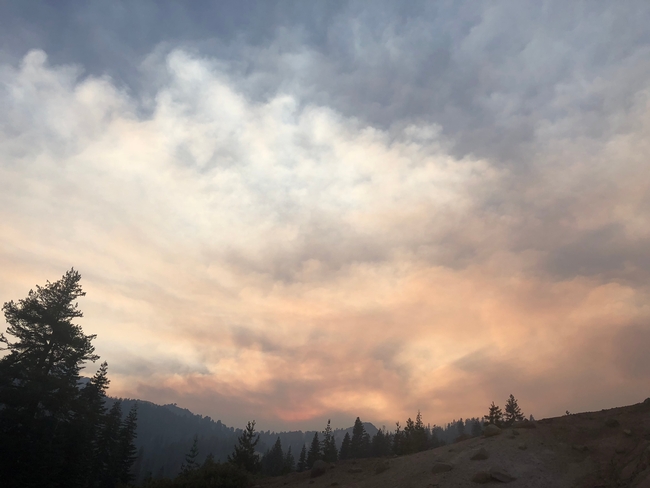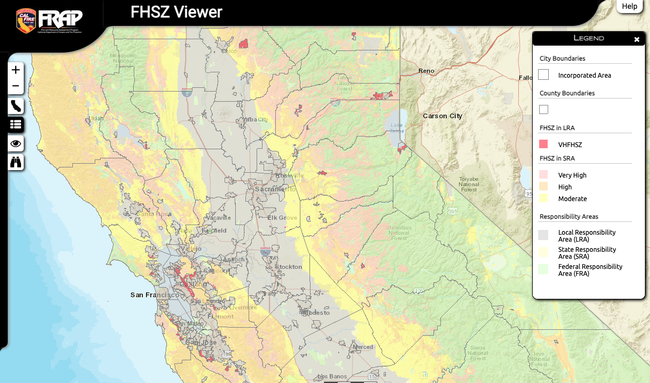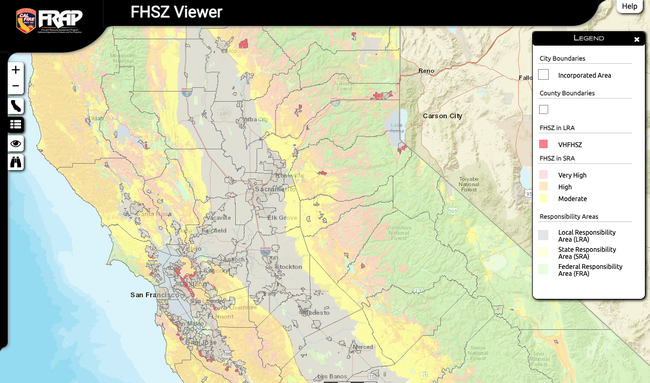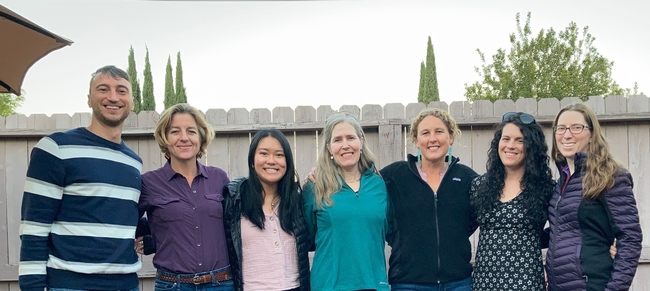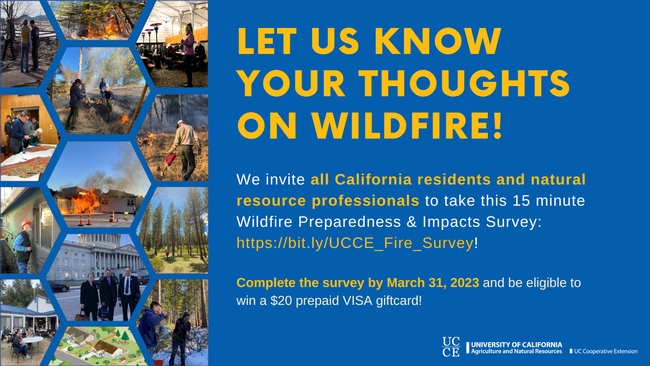- Author: Pamela S Kan-Rice
Wildfire season is in full swing. With so many fires burning around the state, the UC ANR Fire Network team is providing some tips to prepare for evacuation and wildfire smoke.
“The best time to prepare for evacuation is before the wildfire starts,” said Katie Low, Fire Network statewide coordinator.
Low recommends preparing an evacuation bag for every person in your household before a wildfire and keeping it easily accessible.
“Plan to be away from your home for an extended period of time,” she said. “Make the bags light enough to lift into a vehicle.”
Be sure to pack car keys, credit cards, cash, medications, important documents and clothing. See https://ucanr.edu/sites/fire/Safety/Evacuation/Preparing_a_Go-Bag for the full checklist.
There are also several actions you can take to prepare yourself and your family for evacuation, including moving combustible patio furniture inside or sealing up ground or attic vents with plywood or metal tape. More evacuation preparation tips can be found here https://ucanr.edu/sites/fire/Safety/Evacuation/.
Another thing to be mindful of is smoke exposure from wildfires, which is an increasingly common public health hazard to California's communities. Low said: “To prepare for wildfire smoke I am doing a few things:
- Checking the air quality near me at https://fire.airnow.gov
- Limiting my outdoor activity
- Wearing a N95 mask if I'm outside
- Running my air purifier."
There are many great resources that you can use to monitor air quality and understand smoke impacts near you:
- The California Smoke Spotter app ( https://ww2.arb.ca.gov/resources/fact-sheets/california-smoke-spotter…) provides the latest information on prescribed fires and wildfires, air quality and smoke forecasts throughout California.
- The AirNow Fire and Smoke Map (https://fire.airnow.gov) provides current information on PM 2.5, wildfire locations and smoke plumes, and special smoke outlooks when available.
- The California Smoke Blog (https://californiasmokeinfo.blogspot.com) provides smoke outlooks for communities affected by wildfire smoke and other resources to protect yourself from smoke.
- The California Air Resources Board Smoke Ready California webpage (https://ww2.arb.ca.gov/smokereadyca) provides information and resources to protect yourself from smoke including how to create a Clean Air Space, how to wear N95 masks correctly how to construct DIY air cleaners.
- The California Clean Air Centers Map (https://ww2.arb.ca.gov/cleanaircenters) interactive, statewide map where you can find information about permanent and temporary clean air shelters, including their address, operating hours, and contact information.
Learn more about how to prepare for smoke at https://ucanr.edu/sites/fire/Safety/Air_Quality_and_Smoke/. The Fire Network will also be hosting a public smoke readiness webinar on Wednesday, September 4 from 5:30–7 p.m. If you are interested in registering, please email Katie Low (katlow@ucanr.edu) for the signup link.
- Author: Pamela Kan-Rice
The California Board of Forestry and Fire Protection has created a public survey to help develop a baseline estimate of work needed to implement Zone 0 – clearing the first five feet surrounding any structure of combustibles such as woody plants, mulch and wood fences. This will inform their economic impact analysis for the regulations, which are intended to protect homes, businesses and communities.
The board has asked UC ANR staff and academics to distribute the survey through their networks to maximize responses.
The following is suggested text for social media and email sharing:
“Your input is needed! UC Cooperative Extension is partnering with the California Board of Forestry and Fire Protection to develop a new defensible space zone for wildfire resilience within the first 5 feet of a structure, known as Zone 0. We're asking California residents and business owners to help inform cost estimates for the implementation of these new science-driven defensible space standards. Please complete the 5-10 minute survey at https://forms.office.com/g/peGA5QuDfn. It's open through April 5.”
- Author: Pamela Kan-Rice
The California Board of Forestry and Fire Protection has created a public survey to help develop a baseline estimate of work needed to implement Zone 0 – clearing the first five feet surrounding any structure of combustibles such as woody plants, mulch and wood fences. This will inform their economic impact analysis for the regulations, which are intended to protect homes, businesses and communities.
The board has asked UC ANR staff and academics to distribute the survey through their networks to maximize responses.
The following is suggested text for social media and email sharing:
“Your input is needed! UC Cooperative Extension is partnering with the California Board of Forestry and Fire Protection to develop a new defensible space zone for wildfire resilience within the first 5 feet of a structure, known as Zone 0. We're asking California residents and business owners to help inform cost estimates for the implementation of these new science-driven defensible space standards. Please complete the 5-10 minute survey at https://forms.office.com/g/peGA5QuDfn. It's open through April 5.”
- Author: Luca Carmignani
- Author: Katie Low
By taking a brief survey, you can help UC ANR colleagues on the fire team to better understand the wildfire-related needs of Californians. While taking the survey, you'll also learn tips for protecting your home from wildfire.
The new group of Cooperative Extension fire professionals is interested in learning about the concerns of the communities and professionals already working to address these issues. Results from this survey will enhance our ability to partner with residents, landowners, agencies, academics, and other organizations to reduce California's vulnerability to wildfires.
They are asking adult residents and natural resource professionals in California to complete this survey (https://bit.ly/UCCE_Fire_Survey) by March 31.
By filling out this survey, you will help the team develop educational resources and workshops about wildfire preparedness and guide scientific research aimed at helping communities and professionals deal with wildfire risks and impacts.
This survey should take approximately 10 minutes to complete. Your participation in the survey is voluntary and your answers are anonymous. If you share your contact information in the survey, it will not be connected to your answers unless you wish to be contacted for a follow-up interview.
By participating in this study, you will have the option to enter a drawing to win one of fifty $20 VISA gift cards. Your contact information will not be linked to your answers.
This research is being led by a collaboration of UCCE Advisors and Academic Coordinator. If you have any questions about this survey, please contact your nearest fire or forestry professional involved in this survey effort:
- Luca Carmignani, fire advisor, UCCE Los Angeles, Orange, Riverside, and San Diego counties, carmignani@ucanr.edu
- Alison Deak, fire advisor, UCCE Fresno, Madera, and Mariposa counties, aldeak@ucanr.edu
- Katie Low, fire academic coordinator, UCCE Nevada and Placer counties, katlow@ucanr.edu
- Barb Satink Wolfson, fire advisor, UCCE Monterey, San Benito, Santa Clara, and Santa Cruz counties, bsatinkwolfson@ucanr.edu
- Ryan Tompkins, forestry advisor, UCCE Plumas, Sierra, and Lassen counties, rethompkins@ucanr.edu
Feel free to share the survey link with friends and clientele: https://bit.ly/UCCE_Fire_Survey.
For more information about wildfire-related programming from University of California Cooperative Extension, please visit the fire website at https://ucanr.edu/fire or the UC ANR fire Facebook page at https://bit.ly/fireSolutions.
- Author: Pamela Kan-Rice
Discuss with UC ANR colleagues programming they have done to help their local communities recover from wildfire and talk about the kinds of fire recovery outreach you'd like to do.
When: Tuesday, Sept. 29, 11:00 a.m. to noon
Registration Link: http://ucanr.edu/fireprograms
UCCE experts will give short presentations, leaving time for Q & A.
Brought to you by the UC ANR Fire Work Group.
Hear about postfire programs including:
- Wildlands and forests: Forestry Advisor Ryan Tompkins
- Fire Resilient Homes & Landscaping: Environmental Horticulture Advisor Steven Swain
- Livestock and Natural Resources: Natural Resources Advisor Tracy Schohr
- Fire Resources Website: Forestry Advisor and UCANR Fire website god Rick Satomi

